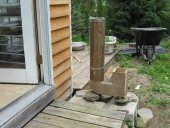posted 2 years ago
I use the back of my hand or my cheek to see if the item is cooler that it should be to tell how dry it is.
Natural clay can be very hard to work with and every place has a slightly different formulation of clay. My last clay pit was 100' from one side to the other produces similar, but different qualities.
Processing the clay is very important. Most people wet process, but on a smaller scale dry processing works well also.
Doing test fires is important as each batch will vitrify at a different temp.
The fit between the clay and the glaze is also important. With the right fit you can take a frozen pot out of the deep freezer and poor boiling water into it with out issues, this test is hard to pass.
Most pit fired items (sounds like that you did) do not get to the temp where they are vitrified. Pit fired and raku pottery are for decoration only and normally get some kind of wax on them.
Burnished pottery that is wood fired can be used for some cooking, but my understanding is they are fragile. These firings are an art on how they are stacked, where the fuel is placed, and the piles are covered in broken pottery to form a type of kiln (not the only way).
Even with "dry" pottery it still is damp and the water boils off at 100*c. Depending on thickness, how item were made, and finish it can take an hour + to boil off all the water.
Around 580*c is when the quartz crystallizes. IMO this would be the coldest you could get away with if you had a lower fire clay, but would still not be vitrified.
Their is to much science involved and a lot of testing of everything to get it all into a few post. When you deal with wild dug clay you start off not knowing any properties of what you dug so lots of testing to even get to the science part. Every mix of clay with vitrify at a different temp.






